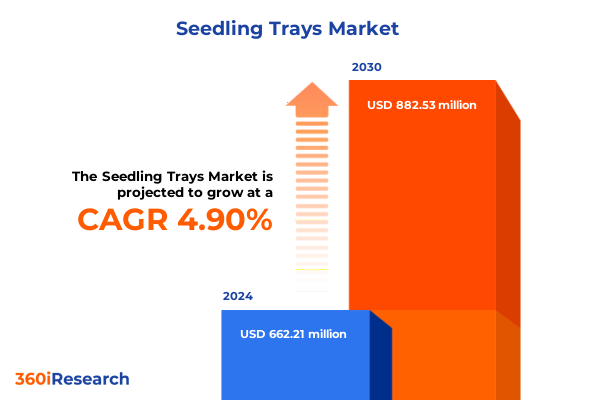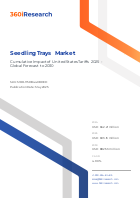The Seedling Trays Market size was estimated at USD 662.21 million in 2024 and expected to reach USD 693.13 million in 2025, at a CAGR 4.90% to reach USD 882.53 million by 2030.

Introduction: The Growing Importance of Seedling Trays in Horticulture
Seedling trays play a vital role in modern horticulture, supporting efficient seed germination and ensuring uniform root development across crops ranging from vegetables to ornamentals. As growers strive for scalable solutions to boost yields and conserve resources, tray design and material selection have become critical differentiators. This executive summary delivers a concise overview of the seedling tray landscape, examining how shifting customer preferences, technological innovation, and evolving regulations drive market dynamics. Demand has surged across end-use sectors, from commercial farming and nurseries to educational research and the burgeoning home gardening market. Distribution models have likewise evolved, harnessing both traditional offline channels and digital storefronts to meet needs for rapid delivery and customization. By dissecting key segments-product shape, material, end-use application and distribution-and assessing regional drivers and provider strategies, this report equips decision-makers with actionable intelligence. Whether evaluating biodegradable substrates versus conventional plastics or understanding the strategic responses to new trade measures, stakeholders will gain clarity on opportunities and challenges in an increasingly complex environment. The following sections delve deeper into transformative trends shaping tomorrow’s seedling tray arena.
Transformative Shifts in the Seedling Trays Landscape
In recent years, the seedling tray market has undergone transformative shifts driven by sustainability imperatives and digitalization. A growing emphasis on eco-friendly cultivation has fueled adoption of biodegradable substrates such as coconut coir, compressed paper and peat-based materials, challenging the longstanding dominance of polyethylene, polypropylene and polystyrene trays. Concurrently, advanced molding techniques and 3D printing capabilities enable precise customization of circular and square/rectangular tray designs, aligning cell dimensions to specific plant species for optimized root architecture. Greenhouse automation platforms now integrate tray handling, irrigation control and health-monitoring sensors, streamlining labor and enhancing yield consistency. Regulatory frameworks such as the EU’s Eco-design Directive and the North American Plastics Pact reinforce circular economy principles, prompting suppliers to innovate or retrofit existing lines. Furthermore, analytics solutions deliver real-time insights into tray performance, informing precision agriculture initiatives that minimize waste and resource consumption. Meanwhile, the surge in home gardening and research-sector applications has intensified demand for small-batch, premium-quality trays. As these developments converge, manufacturers and distributors must adapt product portfolios and channel strategies to stay ahead.
Cumulative Impact of United States Tariffs 2025 on Seedling Trays
Trade policies scheduled for 2025 in the United States impose significant additional duties on imported seedling trays, reshaping competitive dynamics. Tariffs levied on plastic-based trays and clay variants introduce cost pressures that suppliers are passing through to distributors and end users. In response, many producers have accelerated investments in domestic manufacturing facilities and entered strategic alliances to localize supply chains. This shift not only mitigates exposure to import duties but also reduces lead times and supply-chain disruptions. Tariff bands on these imports range widely, prompting distributors to hedge against price swings and explore tariff-exempt sourcing zones. Several companies have diversified supplier bases to stabilize input costs while preserving product availability and quality. Moreover, the heightened cost of traditional plastics is driving a secondary rebound in interest for biodegradable alternatives and recycled resins. Ultimately, the cumulative impact of these trade measures is fostering a landscape where agility, supply-chain resilience and material innovation become competitive imperatives.
Key Segmentation Insights for Seedling Trays
Analysis of product segmentation reveals that square and rectangular trays dominate mechanized propagation workflows due to their compatibility with automated transplanting equipment, while circular trays retain niche applications in specialty nurseries and research settings. Within material segmentation, biodegradable substrates such as coconut coir, compressed paper and peat-based options are gaining traction among eco-conscious growers, even as clay trays maintain a foothold in academic and laboratory environments. Plastic trays-comprising polyethylene, polypropylene, polystyrene and an emerging share of recycled resins-continue to satisfy high-volume commercial farming demands, offering durability and cost efficiency. Wooden trays, although limited in scale, serve artisanal producers prioritizing natural aesthetics and breathability. End-use segmentation highlights robust uptake by commercial farms and nurseries, while home gardeners increasingly seek small-format, biodegradable trays for DIY projects. Educational and research institutions remain loyal to clay and precision-engineered plastics for controlled studies. Distribution channels reflect a dual-track approach: bulk purchases flow through traditional offline networks, whereas online platforms have captured the attention of home gardeners and specialized research suppliers seeking rapid delivery and customization.
This comprehensive research report categorizes the Seedling Trays market into clearly defined segments, providing a detailed analysis of emerging trends and precise revenue forecasts to support strategic decision-making.
- Product
- Material
- End-Use
- Distribution Channel
Key Regional Insights Driving Market Dynamics
The Americas region exhibits strong demand for high-performance plastic trays, driven by large-scale greenhouse operations in the United States and Canada that emphasize automation and yield optimization. Sustainability regulations in California and Canada’s Plastics Pact have accelerated interest in biodegradable and recycled materials. In Europe, regulatory initiatives such as the Single-Use Plastics Directive and Eco-design requirements have catalyzed adoption of circular substrates, compelling suppliers to diversify material portfolios. The Middle East and Africa are experiencing a proliferation of nursery infrastructure investments, boosting the need for affordable plastic and clay trays adapted to arid climates. Asia-Pacific stands out as both a production powerhouse and a consumption leader: China and India account for a large share of global manufacturing exports, while domestic growth in commercial farming and home gardening propels demand for versatile tray solutions. Regional distributors in Japan, South Korea and Australia are pioneering hybrid models, combining offline service with digital order platforms to meet diverse customer needs.
This comprehensive research report examines key regions that drive the evolution of the Seedling Trays market, offering deep insights into regional trends, growth factors, and industry developments that are influencing market performance.
- Americas
- Asia-Pacific
- Europe, Middle East & Africa
Key Companies Shaping the Seedling Trays Sector
The competitive landscape encompasses a wide array of established manufacturers and emerging innovators. Alagundagi Industries Pvt. Ltd and Bharat Polymer Extrusions maintain strong positions in plastic tray production, while Blue Stallion Equipments (P) Ltd. and Cococraft specialize in precision-engineered designs. Coconut Products Impex and G AND N FORTUNE LIMITED lead efforts in coconut-coir-based trays, complemented by Gajjar Polymers and Genuine Fert & Pest Private Limited, which bridge biodegradable and plastic offerings. Firms such as Goyal Agri Products and INSUTECH have diversified into hybrid resin composites. JAIN AGRO PRODUCTS and Kaveri Agri Products emphasize clay and peat-based solutions, and Kunal Trading Company leverages distribution networks across South Asia. Neelkanth Agro Forestry and Nityanand Agro Ltd serve nurseries with wooden and eco-friendly formats. Rashmi Plastics, Sabras Plastic and Sharad Agro Engineers focus on large-scale polyethylene and polypropylene trays. Shenzhen Yuyi Technology Co., Ltd. and Xiamen Bestpoly Plastic Co., Ltd. drive capacity expansion in China, while SHREE BALAJI AGRO PLAST, Shree Sadguru Packaging Industries and Star Agro India enhance local market reach. Ugaoo and West Coast Seeds add a retail-focused dimension, rounding out a dynamic vendor ecosystem.
This comprehensive research report delivers an in-depth overview of the principal market players in the Seedling Trays market, evaluating their market share, strategic initiatives, and competitive positioning to illuminate the factors shaping the competitive landscape.
- Alagundagi Industries Pvt. Ltd
- Bharat Polymer Extrusions
- Blue Stallion Equipments (P) Ltd.
- Cococraft
- Coconut Products Impex
- G AND N FORTUNE LIMITED
- Gajjar Polymers
- Genuine Fert & Pest Private Limited
- Goyal Agri Products
- INSUTECH
- JAIN AGRO PRODUCTS
- Kaveri Agri Products
- Kunal Trading Company
- Neelkanth Agro Forestry
- Nityanand Agro Ltd
- Rashmi Plastics
- Sabras Plastic
- Sharad Agro Engineers
- Shenzhen Yuyi Technology CO., LTD.
- SHREE BALAJI AGRO PLAST
- Shree Sadguru Packaging Industries
- Star Agro India
- Ugaoo
- West Coast Seeds
- Xiamen Bestpoly Plastic Co., Ltd.
Actionable Recommendations for Industry Leaders
Industry leaders should prioritize diversification of material portfolios by integrating biodegradable substrates and recycled resins alongside traditional plastics. Investing in modular production lines will enable rapid format changes between circular and square tray geometries, meeting both mechanized and artisanal requirements. Strengthening supply-chain resilience through regional manufacturing hubs can mitigate tariff exposure and logistics bottlenecks. Expanding direct-to-consumer channels and e-commerce capabilities will capture the growing home-gardening segment, while strategic alliances with greenhouse automation providers can embed tray solutions within integrated cultivation platforms. Research and development collaborations with academic institutions can accelerate innovation in compostable materials and digital twin simulations for production planning. Implementing end-of-life recycling programs will reinforce circular-economy credentials and appeal to sustainability-driven customers. Finally, adopting advanced analytics for inventory optimization and demand forecasting-even amid volatile trade environments-will help companies balance service levels with cost efficiencies.
Explore AI-driven insights for the Seedling Trays market with ResearchAI on our online platform, providing deeper, data-backed market analysis.
Ask ResearchAI anything
World's First Innovative Al for Market Research
Conclusion: Adapting to a Dynamic Seedling Trays Marketplace
The seedling tray market stands at a critical juncture, shaped by evolving customer needs, sustainability mandates and shifting trade policies. Stakeholders who embrace material innovation, invest in automation and cultivate supply-chain agility will secure competitive advantages. Regional dynamics underscore the importance of localized strategies and adaptive distribution models. Meanwhile, segmentation insights highlight opportunities to tailor offerings for mechanized farming, research institutions and the burgeoning home-gardening community. As players navigate tariff-induced cost pressures and regulatory constraints, collaboration across the value chain-from raw material suppliers to tray designers and distributors-will prove essential. Ultimately, the capacity to anticipate emerging trends, pivot rapidly and maintain a balanced product portfolio will determine market leadership. By applying the recommendations outlined above, industry participants can turn challenges into growth catalysts and shape a resilient, sustainable future for the seedling tray sector.
This section provides a structured overview of the report, outlining key chapters and topics covered for easy reference in our Seedling Trays market comprehensive research report.
- Preface
- Research Methodology
- Executive Summary
- Market Overview
- Market Dynamics
- Market Insights
- Cumulative Impact of United States Tariffs 2025
- Seedling Trays Market, by Product
- Seedling Trays Market, by Material
- Seedling Trays Market, by End-Use
- Seedling Trays Market, by Distribution Channel
- Americas Seedling Trays Market
- Asia-Pacific Seedling Trays Market
- Europe, Middle East & Africa Seedling Trays Market
- Competitive Landscape
- ResearchAI
- ResearchStatistics
- ResearchContacts
- ResearchArticles
- Appendix
- List of Figures [Total: 24]
- List of Tables [Total: 282 ]
Call-To-Action: Engage with Ketan Rohom for In-Depth Market Research
To access the full suite of insights, detailed segment analyses and competitive benchmarks, contact Ketan Rohom, Associate Director of Sales & Marketing. He will guide you through tailored licensing options and delivery formats to ensure your organization gains the strategic intelligence needed to thrive in the evolving seedling tray market. Reach out today to secure your copy and transform market complexity into actionable opportunity.

- How big is the Seedling Trays Market?
- What is the Seedling Trays Market growth?
- When do I get the report?
- In what format does this report get delivered to me?
- How long has 360iResearch been around?
- What if I have a question about your reports?
- Can I share this report with my team?
- Can I use your research in my presentation?




